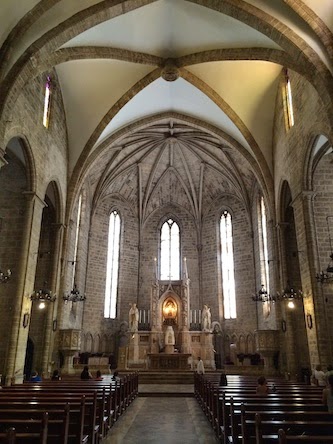 |
| The Gold-Adorned Ceiling of Valencia’s Iglesia Parroquial de San Martín |
It can be said that it’s hard to see Europe through all the cathedrals.
It’s true: every time you turn around in Europe, you find another cathedral. Well, technically, you find another church: a cathedral is supposed to be the home of a bishop. Here in Valencia, we’ve visited about a half-dozen churches, and the only place outside the old town area we’ve journeyed to is the beach. In one particular spot, if Lori and I were to join hands and stretch arms out, we could just about touch both the Cathedral of Valencia and its next-door neighbor the Basilica de la Virgen de los Desamparados (the Basilica of the Virgin of the Homeless).
Valencia has a pretty typical density of grand churches, but for a true overdose of churches you only have to spend a few hours in Rome: we know of at least one Roman square where you can visit three great churches without leaving the square. If you were to set out to attend mass at a different church in Rome each day, it might truly take a few years to accomplish the task. It’s not uncommon to hear an American tourist whining to a family member, Oh, no! Not another church!
Someone once asked me why there are so many churches in Europe, and in such close proximity to one another. I’ll try to answer the same question for you.
 |
| Stark Stone and Beautiful Altarpiece of Valencia’s Iglesia de San Agustín |
First of all, there are true-blue cathedrals, the home of a bishop. Most people think of a bishop as the head of a diocese, a regional or local collection of parishes, which of course is the typical pastoral duty of a bishop. But as the fundamental role of a bishop is to teach church doctrine, and there are organizations with a doctrinal mission that aren’t dioceses, some organizations are lead by a bishop without a diocese, yet he needs a cathedral to call home. This can lead to some cities–like Rome–having multiple cathedrals.
Another reason a church can be built is to act as the spiritual home–either the headquarters or the regional home–of a religious organization, such as an order of priests or an order of nuns. Here in Valencia, for example, only three blocks from the Cathedral of Valencia is a Jesuit church, the Iglesia del Sagrado Corazón de Jesús la Campañía (the Church of the Sacred Heart of Jesus the Companion…we think). And as every Catholic organization requires a nod from Rome, their world headquarters, replete with their own church, is often located in Rome.
But it’s not just their headquarters or regional offices that require churches; religious organizations, particularly the holy orders, that operate in a community often provide their own church. Hence, monasteries and convents alike–even if they’re not headquarters–often have their own basilica or church.
Sometimes a church was built to house a specific relic. As we recently blogged, there are no shortage of religious relics in Europe, and in some cases grand churches were built to be part of the pilgrim’s attraction to come see the relic.
On occasion a church was built to honor a specific saint, often by the followers (also known as their cult) of that saint or their rich benefactors. The church might have been erected on the spot of a miracle associated with the saint, it might have been built to house relics of the saint (including the saint’s remains), or it might have been built as a pilgrimage destination for devotees of the saint.
Speaking of rich benefactors, monarchs and rich families throughout European history–and there were no shortage of them–sometimes built churches with their own fortunes or bequeathed money for the purpose. There was no better way to ensure your personal or family name’s good reputation than to have a church associated with it. It was also a great way to endear yourself to the local community and even to help ensure your place in heaven.
Finally, churches were even sometimes built as simple parish churches: built by a local community of hard-working Christians who pooled their resources, and with the blessing of their diocesan bishop, established a parish for themselves and built a church the good “old-fashioned” way.
 |
|||
| The Altar and Madonna of Valencia’s Basilica de la Virgen de los Desamparados |






